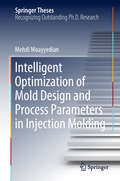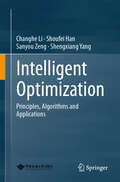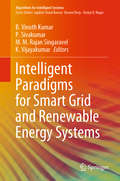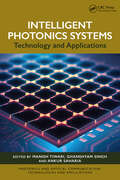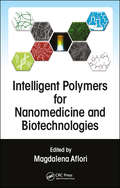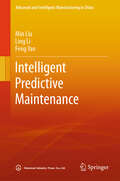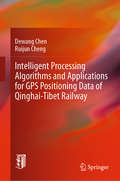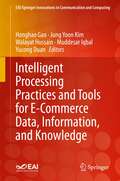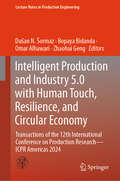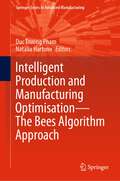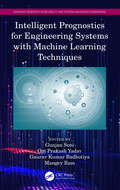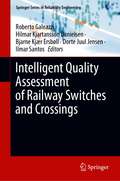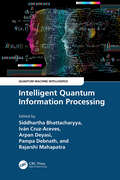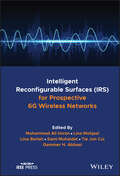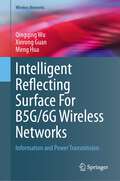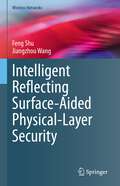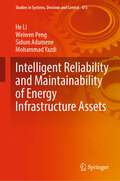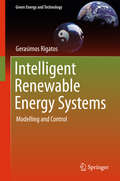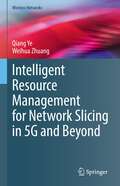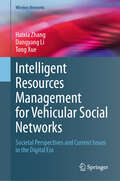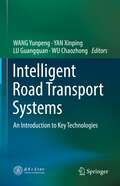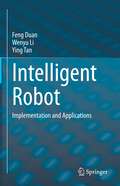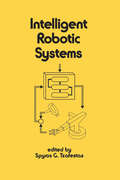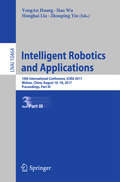- Table View
- List View
Intelligent Optimization of Mold Design and Process Parameters in Injection Molding (Springer Theses)
by Mehdi MoayyedianThis book describes an effective framework for setting the right process parameters and new mold design to reduce the current plastic defects in injection molding. It presents a new approach for the optimization of injection molding process via (i) a new mold runner design which leads to 20 percent reduction in scrap rate, 2.5 percent reduction in manufacturing time, and easier ejection of injected part, (ii) a new mold gate design which leads to less plastic defects; and (iii) the introduction of a number of promising alternatives with high moldability indices. Besides presenting important developments of relevance academic research, the book also includes useful information for people working in the injection molding industry, especially in the green manufacturing field.
Intelligent Optimization: Principles, Algorithms and Applications
by Shengxiang Yang Sanyou Zeng Changhe Li Shoufei HanThis textbook comprehensively explores the foundational principles, algorithms, and applications of intelligent optimization, making it an ideal resource for both undergraduate and postgraduate artificial intelligence courses. It remains equally valuable for active researchers and individuals engaged in self-study. Serving as a significant reference, it delves into advanced topics within the evolutionary computation field, including multi-objective optimization, dynamic optimization, constrained optimization, robust optimization, expensive optimization, and other pivotal scientific studies related to optimization. Designed to be approachable and inclusive, this textbook equips readers with the essential mathematical background necessary for understanding intelligent optimization. It employs an accessible writing style, complemented by extensive pseudo-code and diagrams that vividly illustrate the mechanisms, principles, and algorithms of optimization. With a focus on practicality, this textbook provides diverse real-world application examples spanning engineering, games, logistics, and other domains, enabling readers to confidently apply intelligent techniques to actual optimization problems. Recognizing the importance of hands-on experience, the textbook introduces the Open-source Framework for Evolutionary Computation platform (OFEC) as a user-friendly tool. This platform serves as a comprehensive toolkit for implementing, evaluating, visualizing, and benchmarking various optimization algorithms. The book guides readers on maximizing the utility of OFEC for conducting experiments and analyses in the field of evolutionary computation, facilitating a deeper understanding of intelligent optimization through practical application.
Intelligent Paradigms for Smart Grid and Renewable Energy Systems (Algorithms for Intelligent Systems)
by P. Sivakumar K. Vijayakumar B. Vinoth Kumar M. M. Rajan SingaravelThis book addresses and disseminates state-of-the-art research and development in the applications of intelligent techniques for smart grids and renewable energy systems. This helps the readers to grasp the extensive point of view and the essence of the recent advances in this field. The book solicits contributions from active researchers which include theory, case studies and intelligent paradigms pertaining to the smart grid and renewable energy systems. The prospective audience would be researchers, professionals, practitioners and students from academia and industry who work in this field.
Intelligent Photonics Systems: Technology and Applications (Photonics and Optical Communication: Technologies and Applications)
by Ghanshyam Singh Manish Tiwari Ankur SahariaThe text comprehensively discusses the implementation of sensor systems using artificial intelligence, quantum device and circuit with artificial intelligence, and biomedical implementation of artificial intelligence-based optoelectronic circuits. It covers important topics such as photonic communication, optical and photonics neural networks, neuromorphic computing, quantum optics, and artificial intelligence leap in optical sensors, including biophotonics.This book:• Provides insights about the advancement in optoelectronics devices using artificial intelligence.• Discusses artificial intelligence–integrated photonic crystal fiber-based devices.• Covers artificial intelligence–integrated quantum networks for 6G communication and artificial intelligence–enhanced quantum optical devices.• Presents neuromorphic computing for photonic circuits and deep learning–enabled optical sensors.• Showcases development in artificial intelligence for biophotonics applications, deep learning revolution in optical networks.It is primarily written for senior undergraduate students, graduate students, and academic researchers in the fields of electrical engineering, electronics and communications engineering, and computer engineering.
Intelligent Polymers for Nanomedicine and Biotechnologies
by Magdalena AfloriAlmost all synthetic materials over time induce some level of inflammation and fibrosis. Therefore, even though the successes of biomaterials science in producing acceptable solutions to the problem of biocompatibility have been remarkable, there remains enormous opportunity for improvement. The goal is the development of intelligent materials that replicate and mimic the ability of tissues and biological materials to adapt and renew. <P><P>This book describes the synthesis and the analysis of new smart polymeric materials and their practical implications in nanomedicine and biotechnology. It offers a comprehensive overview, gathering recent and innovative research on multiple aspects within the field of smart polymeric materials that offer new perspectives in developing current advanced biotechnologies. The text contains both experimental and theoretical issues that reflect the impact of the materials characteristics in target applications. It deals with recent advances in the design of new polymeric materials for advanced applications but also on the study of their structure-properties relationship in order to move from completely inert, static structures to flexible ones capable to respond to environmental changes.
Intelligent Predictive Maintenance (Advanced and Intelligent Manufacturing in China)
by Ling Li Min Liu Feng YanIn the field of equipment/product operation and maintenance (O&M) services, the new generation of information technologies such as the internet, big data, and artificial intelligence are deeply integrated with O&M services to form an internet-based Maintenance Repair & Operation (MRO) service network and an intelligent service environment. To deal with the uncertainties of multiple collaborative entities and highly random equipment failures in the large-scale MRO network, this book establishes the theory, technology, and methods of Intelligent Predictive Maintenance (IPdM) for the MRO service network through the study of high-quality acquisition and integration of multi-source heterogeneous data, data-driven equipment fault diagnosis and prediction, large-scale maintenance decision-making, feedback, and control. The book systematically elaborates on the emerging theories, technologies, and methods in the field of equipment/product O&M services, covering a wide range of topics with rich contents. It emphasizes both systematic and scientific approaches as well as practicality. It offers both comprehensive and specialized discussions to reflect the strategic deployment and implementation of China's new generation of intelligent manufacturing and artificial intelligence in this field. The basis of English translation of this book, originally in Chinese, was facilitated by artificial intelligence. The content was later revised by the author for accuracy.
Intelligent Processing Algorithms and Applications for GPS Positioning Data of Qinghai-Tibet Railway
by Dewang Chen Ruijun ChengTaking the Qinghai–Tibet Railway as an example, this book introduces intelligent processing for Global Positioning Data (GPS) data. Combining theory with practical applications, it provides essential insights into the Chinese Qinghai–Tibet Railway and novel methods of data processing for GPS satellite positioning, making it a valuable resource for all those working with train control systems, train positioning systems, satellite positioning, and intelligent data processing. As satellite positioning guarantees the safe and efficient operation of train control systems, it focuses on how to best process the GPS data collected, including methods for error detection, reduction and information fusion.
Intelligent Processing Practices and Tools for E-Commerce Data, Information, and Knowledge (EAI/Springer Innovations in Communication and Computing)
by Honghao Gao Muddesar Iqbal Jung Yoon Kim Walayat Hussain Yucong DuanThis book discusses recent research and applications about intelligent processing practices and tools for e-commerce data, information and knowledge. The authors first explain how advances in intelligent processing of data, information and knowledge that has wildly been used in e-commerce applications. They then show how this brings new opportunities and challenges for processing e-commerce data, information and knowledge. The book, made up of contributions from both academia and industry, aims to present advances in artificial intelligence to collect, process, and mining Data, information and knowledge, such as new algorithms and techniques in the field, foundational theory and systems, as well as practical e-commerce applications. Some of the topics discussed include AI for e-commerce, such as machine learning, deep learning; personalized service recommendation to e-commerce; modeling, description, and verification for data, information and knowledge; and task scheduling and performance optimization for large-scale concurrency.
Intelligent Production and Industry 5.0 with Human Touch, Resilience, and Circular Economy: Transactions of the 12th International Conference on Production Research – ICPR Americas 2024 (Lecture Notes in Production Engineering)
by Bopaya Bidanda Dušan N. Šormaz Omar Alhawari Zhaohui GengThis volume contains the papers presented at the 12th International Conference on Production Research – Americas, ICPR Americas 2024. The focus and theme of the conference was Intelligent Production and Industry 5.0 with Human touch, Resilience, and Circular Economy. The conference had the majority of authors from the Western Hemisphere, thus providing readers with the current research topics and results in that region towards establishing Industry 5.0 and resilient, intelligent production methods in the theory and practice of production research. As such, the volume establishes direction for the further advancement of circular economy and human advancement. What areas are covered? The book covers the broad area of production research, including the following topics: Intelligent Production for Circular Economy, Smart Factories and Industrial Internet of Things, Sustainable Manufacturing and Engineering, Modelling and Simulation of Manufacturing and Services, Strategies and Approaches to Develop Production Resilience, Digital and Cyber Manufacturing and Services for Industry 4.0 & 5.0, Data Analytics and Smart Manufacturing, Manufacturing Systems and Supply Chains, Human Factors Engineering, and many others shown inside the book. What is the main focus? The presented papers cover new theories in production research, with emphasis on digital and smart manufacturing, lean and agile manufacturing, and sustainable manufacturing and engineering. However, as the ICPR conferences also cover applications of developed theories in industry, it is expected that about 1/3 of papers will have application focus. Who will be interested in reading? The book aims to get the attention of graduate students and early researchers eager to learn new methodologies and theories of production research as its primary audience. However, advanced undergraduate students may also be tempted to learn the topics of the conference as a potential medium in their choices of careers, particularly when considering graduate degrees. This is the first edition of the book, but it also continues the tradition of proceedings from previous ICPR global and regional conferences.
Intelligent Production and Manufacturing Optimisation—The Bees Algorithm Approach (Springer Series in Advanced Manufacturing)
by Duc Truong Pham Natalia HartonoThis book is the first work dedicated to the Bees Algorithm. Following a gentle introduction to the main ideas underpinning the algorithm, the book presents recent results and developments relating to the algorithm and its application to optimisation problems in production and manufacturing. With the advent of the Fourth Industrial Revolution, production and manufacturing processes and systems have become more complex. To obtain the best performance from them requires efficient and effective optimisation techniques that do not depend on the availability of process or system models. Such models are usually either not obtainable or mathematically intractable due to the high degrees of nonlinearities and uncertainties in the processes and systems to be represented. The Bees Algorithm is a powerful swarm-based intelligent optimisation metaheuristic inspired by the foraging behaviour of honeybees. The algorithm is conceptually elegant and extremely easy to apply. All it needs to solve an optimisation problem is a means to evaluate the quality of potential solutions. This book demonstrates the simplicity, effectiveness and versatility of the algorithm and encourages its further adoption by engineers and researchers across the world to realise smart and sustainable manufacturing and production in the age of Industry 4.0 and beyond.
Intelligent Prognostics for Engineering Systems with Machine Learning Techniques (Advanced Research in Reliability and System Assurance Engineering)
by Mangey Ram Om Prakash Yadav Gunjan Soni Gaurav Kumar BadhotiyaThe text discusses the latest data-driven, physics-based, and hybrid approaches employed in each stage of industrial prognostics and reliability estimation. It will be a useful text for senior undergraduate, graduate students, and academic researchers in areas such as industrial and production engineering, electrical engineering, and computer science. The book Discusses basic as well as advance research in the field of prognostics. Explores integration of data collection, fault detection, degradation modeling and reliability prediction in one volume. Covers prognostics and health management (PHM) of engineering systems. Discusses latest approaches in the field of prognostics based on machine learning. The text deals with tools and techniques used to predict/ extrapolate/ forecast the process behavior, based on current health state assessment and future operating conditions with the help of Machine learning. It will serve as a useful reference text for senior undergraduate, graduate students, and academic researchers in areas such as industrial and production engineering, manufacturing science, electrical engineering, and computer science.
Intelligent Quality Assessment of Railway Switches and Crossings (Springer Series in Reliability Engineering)
by Roberto Galeazzi Hilmar Kjartansson Danielsen Bjarne Kjær Ersbøll Dorte Juul Jensen Ilmar SantosThis book focuses on the latest scientific and technological advancements in the field of railway turnout engineering. It offers a holistic approach to the scientific investigation of the factors and mechanisms determining performance degradation of railway switches and crossings (S&Cs), and the consequent development of condition monitoring systems that will enable infrastructure managers to transition towards the implementation of predictive maintenance. The book is divided into three distinct parts. Part I discusses the modelling of railway infrastructure, including switch and crossing systems, while Part II focuses on metallurgical characterization. This includes the microstructure of in-field loaded railway steel and an analysis of rail screw failures. In turn, the third and final part discusses condition monitoring and asset management. Given its scope, the book is of interest to both academics and industrial practitioners, helping them learn about the various challenges characterizing this engineering domain and the latest solutions to properly address them.
Intelligent Quantum Information Processing (Quantum Machine Intelligence)
by Siddhartha Bhattacharyya Arpan Deyasi Pampa Debnath Rajarshi Mahapatra Iván Cruz-AcevesThe book discusses the foundations of intelligent quantum information processing applied to several real-life engineering problems, including intelligent quantum systems, intelligent quantum communication, intelligent process optimization, and intelligent quantum distributed networks.This book:• Showcases a detailed overview of different quantum machine learning algorithmic frameworks.• Presents real-life case studies and applications.• Provides an in-depth analysis of quantum mechanical principles.• Provides a step-by-step guide in the build-up of quantum inspired/quantum intelligent information processing systems.• Provides a video demonstration on each chapter for better understanding.It will serve as an ideal reference text for graduate students and academic researchers in fields such as electrical engineering, electronics and communication engineering, computer engineering, and information technology.
Intelligent Reconfigurable Surfaces (The ComSoc Guides to Communications Technologies)
by Muhammad Ali Imran Tie Jun Cui Qammer H. Abbasi Lina Mohjazi Lina Bariah Sami MuhaidatIntelligent Reconfigurable Surfaces (IRS) for Prospective 6G Wireless Networks Authoritative resource covering preliminary concepts and advanced concerns in the field of IRS and its role in 6G wireless systems Intelligent Reconfigurable Surfaces (IRS) for Prospective 6G Wireless Networks provides an in-depth treatment of the fundamental physics behind reconfigurable metasurfaces, also known as intelligent reflecting surfaces (IRS), and outlines the research roadmap towards their development as a low-complexity and energy-efficient solution aimed at turning the wireless environment into a software-defined entity. The text demonstrates IRS from different angles, including the underlying physics, hardware architecture, operating principles, and prototype designs. It enables readers to grasp the knowledge of the interplay of IRS and state-of-the-art technologies, examining the advantages, key principles, challenges, and potential use-cases. Practically, it equips readers with the fundamental knowledge of the operational principles of reconfigurable metasurfaces, resulting in its potential applications in various intelligent, autonomous future wireless communication technologies. To aid in reader comprehension, around 50 figures, tables, illustrations, and photographs to comprehensively present the material are also included. Edited by a team of highly qualified professionals in the field, sample topics covered are as follows: Evolution of antenna arrays design, introducing the fundamental principles of antenna theory and reviewing the stages of development of the field; Beamforming design for IRS-assisted communications, discussing optimal IRS configuration in conjunction with overviewing novel beamforming designs; Reconfigurable metasurfaces from physics to applications, discussing the working principles of tunable/reconfigurable metasurfaces and their capabilities and functionalities; IRS hardware architectures, detailing the general hardware architecture of IRS and features related to the IRS’s main operational principle; Wireless communication systems assisted by IRS, discussing channel characterization, system integration, and aspects related to the performance analysis and network optimization of state-of-the-art wireless applications. For students and engineers in wireless communications, microwave engineering, and radio hardware and design, Intelligent Reconfigurable Surfaces (IRS) for Prospective 6G Wireless Networks serves as an invaluable resource on the subject and is a useful course accompaniment for general Antenna Theory, Microwave Engineering, Electromagnetics courses.
Intelligent Reflecting Surface For B5G/6G Wireless Networks: Information and Power Transmission (Wireless Networks)
by Qingqing Wu Xinrong Guan Meng HuaThis book provides comprehensive insights into the theory, models, and unique characteristics of intelligent reflecting surface (IRS) and its appealing applications in wireless information and power transmission for B5G/6G. It is organized as follows:Chapter 1 gives an overview of the fundamentals of IRS, including the signal and channel models of IRS, its hardware architecture, advantages and practical constraints. Chapter 2, 3 and 4 focus on how to optimize the joint design of active and passive beamforming for three types of IRS-aided wireless information/energy transmission systems, namely IRS-aided power transfer (WPT), IRS-aided simultaneous wireless information and power transfer (SWIPT) and IRS-aided wireless powered communication networks (WPCN). Chapter 2 specifically presents a general framework design for IRS-aided WPT systems from the perspectives of energy beamforming design and channel estimation, while the dynamic IRS beamforming design is also discussed. Chapter 3 thoroughly studies the IRS-aided SWIPT for achieving better R-E trade-off, wherein two different designs based on weighted sum-power maximization at energy users (EUs) and under individual quality-of-service (QoS), requirements at both information users (IUs) and EUs are investigated. Chapter 4 presents three paradigms of IRS-aided WPCN, i.e., IRS-aided half-duplex (HD) WPCN, IRS-aided full-duplex (FD) WCPN and IRS-aided multiple-input-multiple-output (MIMO) FD WPCN. The authors present some related emerging topics, e.g., active IRS aided wireless communications and IRS-aided unmanned aerial vehicle (UAV) communications in chapter 5. This book targets postgraduate students studying electrical engineering and computer science, and can be used as a secondary textbook. Professionals, researchers and engineers working in wireless networks will also find this book useful as a reference.
Intelligent Reflecting Surface-Aided Physical-Layer Security (Wireless Networks)
by Jiangzhou Wang Feng ShuThis book discusses the problems of Physical Layer Security (PLS) in Intelligent Reflecting Surface (IRS)-assisted wireless networks.It also discusses the corresponding methods to solve these problems in a comprehensive style. Furthermore, some potential challenges are well analyzed.This book is divided into 11 chapters. Chapter 1 introduces the propagation characteristics of IRS-aided PLS communications. From Chapter 2 to Chapter 10,The authors mainly provide deep investigations of different PLS problems of IRS-aided wireless networks, namely, directional modulation (DM) networks. Chapter 11 draws a conclusion and includes the future research directions.Researchers working in wireless communications, or advanced-level computer science or electrical engineering students, can learn about secure communication in the physical layer through our book.Professionals or engineers working in this field will also benefit from this book.
Intelligent Reliability and Maintainability of Energy Infrastructure Assets (Studies in Systems, Decision and Control #473)
by He Li Mohammad Yazdi Weiwen Peng Sidum AdumeneThis book reviews and presents several advanced approaches to energy infrastructure assets' intelligent reliability and maintainability. Each introduced model provides case studies indicating high efficiency, robustness, and applicability, allowing readers to utilize them in their understudy intelligent reliability and maintainability of energy infrastructure assets domains. The book begins by reviewing the state-of-the-art research on the reliability and maintainability of energy infrastructure assets and emphasizes the intelligent tools and methods proposed from a bibliometric and literature review point of view. It then progresses logically, dedicating a chapter to each approach, dynamic Bayesian modeling network, convolutional neural network model, global average pooling-based convolutional Siamese network, an integrated probabilistic model for the failure consequence assessment, and more. This book interests professionals and researchers working in reliability and maintainability and postgraduate and undergraduate students studying intelligent reliability applications and energy infrastructure assets' maintainability.
Intelligent Renewable Energy Systems
by Gerasimos RigatosFocused on renewable energy systems and the development of information and communication technologies (ICTs) for their integration in smart grids, this book presents recent advances and methods that help to ensure that power generation from renewable sources remains stable, that power losses are minimized, and that the reliable functioning of these power generation units is maintained. The book highlights key topics and technologies for renewable energy systems including the intelligent control of power generators, power electronics that connect renewable power generation units to the grid, and fault diagnosis for power generators and power electronics. In particular, the following topics are addressed: * Modeling and control of power generators (PMSGs, DFIGs); * Modeling and control of power electronics (converters, inverters); * Modeling and fault diagnosis of the transmission and distribution Grid; and* Modelling and control of distributed power generation units (interconnected synchronous generators or photovoltaic units). Because of the above coverage, members of the wider engineering community will find that the nonlinear control and estimation methods presented provide essential insights into the functioning of renewable energy power systems, while the academic community will find the book a valuable textbook for undergraduate or graduate courses on renewable energy systems.
Intelligent Resource Management for Network Slicing in 5G and Beyond (Wireless Networks)
by Weihua Zhuang Qiang YeThis book provides a timely and comprehensive study of developing efficient network slicing frameworks in both 5G wireless and core networks. It also presents protocol stack layer perspectives, which includes virtual network topology design, end-to-end delay modeling, dynamic resource slicing, and link-layer and transport-layer protocol customization. This book provides basic principles, concepts and technologies for communication, computing and networking. Optimization and queueing analysis techniques are applied to solving different problems for network slicing illustrated in this book as well.Researchers working in the area of network slicing in 5G networks and beyond, and advanced-level students majoring in electrical engineering, computer engineering and computer science will find this book useful as a reference or secondary textbook. Professionals in industry seeking solutions to resource management for 5G networks and beyond will also want to purchase this book.
Intelligent Resource Management in Vehicular Networks (Wireless Networks)
by Xuemin Sherman Shen Qiang Ye Haixia PengThis book provides a comprehensive investigation on new technologies for future vehicular networks. The authors propose different schemes to efficiently manage the multi-dimensional resources for supporting diversified applications. The authors answer the questions of why connected and automated vehicle technology should be considered; how the multi-access edge computing (MEC) and unmanned aerial vehicle (UAV) technologies can be helpful to vehicular networks; how to efficiently manage the multi-dimensional resources to support different vehicular applications with guaranteed quality-of-service (QoS) requirements; and how to adopt optimization and AI technologies to achieve resource management in vehicular networks. The book is pertinent to researchers, professionals, academics and students in vehicular technologies.
Intelligent Resources Management for Vehicular Social Networks: Societal Perspectives and Current Issues in the Digital Era (Wireless Networks)
by Haixia Zhang Dongyang Li Tong XueThis book explores integrating behavior prediction with artificial intelligence-driven resource management to provide a transformative framework for optimizing vehicular social networks (VSNs). The book starts by providing an overview of the key issues encountered in VSNs, including the dynamic and unpredictable nature of vehicular mobility, varying communication demands, and the need for efficient resource allocation. A significant portion of the book is dedicated to exploring behavior prediction models for vehicles in VSNs. By analyzing the past movements, interactions, and social behaviors of vehicles, this book presents various prediction algorithms to anticipate future positions, communication patterns, and resource requirements. With behavior prediction as a foundation, the book delves into the design and implementation of intelligent resource management systems for VSNs. It demonstrates how predictive capabilities empower these systems to allocate communication, computing and caching resources dynamically. The book extensively evaluates the proposed intelligent resource management approach through extensive simulations and practical experiments. The results showcase the effectiveness of the system, highlighting significant improvements in network performance compared to traditional resource allocation methods. These findings validate the potential of behavior prediction and intelligent resource management in revolutionizing VSNs. Finally, this book provides conclusions and promising directions, hoping to stimulate future research outcomes in the field of vehicular networks from different perspectives. The book serves as an invaluable resource for researchers, engineers, and industry professionals interested in advancing the field of vehicular networks and harnessing behavior prediction to create efficient, safe, and intelligent VSNs.
Intelligent Road Transport Systems: An Introduction to Key Technologies
by Wang Yunpeng Yan Xinping Lu Guangquan Wu ChaozhongIn recent years, the application of intelligent transportation systems (ITS) has steadily expanded, and has become a hot spot of common interest to universities, scientific research institutes, enterprises and institutions in the transportation field. ITS is the product of the deep integration of modern high-tech in the transportation industry, and its development has accompanied that of modern high-tech. ITS is now also becoming part of the Internet of Things (IoT), and is expected to contribute significantly to making our cities smarter and connecting with other infrastructure. Although there are many monographs and textbooks on intelligent transportation, with the advancement of technology and changes in demand, the key technologies of ITS are also rapidly changing.This book chiefly focuses on the main technologies of ITS, examining them from four perspectives: “sense” (perception and management of traffic information, chapters 2 & 3), “transmission” (interaction of traffic information, chapter 4), “prediction” (prediction of traffic states, chapter 6) and “application” (intelligent transportation applications, chapters 6 through 10). Given its scope, the book can be used as a textbook for undergraduates or graduates, as well as a reference book for research institutes and enterprises.This book emphasizes the use of basis traffic engineering principles and state-of-art methodologies to develop functional designs. It largely reflects the authors’ own experience in adapting these methodologies to ITS design. For example, the book addresses various forms of data collection, models used to predict and evaluate traffic states, comprehensive description in connected vehicles, applications for users and traffic managers, etc. The knowledge gained here will allow designers to estimate the performance differences among alternatives and gauge their potential benefits for functional design purposes. To gain the most from the book, readers should be somewhat familiar with the field of traffic engineering and interested in ITS.
Intelligent Robot: Implementation and Applications
by Ying Tan Feng Duan Wenyu LiToday, the development of robots is making steady advances. In particular, the Robot Operating System (ROS) offers a unified platform that greatly facilitates the development of robots and has become a new hotspot for learning and application in the field of robotics research.This book introduces readers to the key technologies and development methods for ROS-based intelligent robots. Covering both the development history of robots and various aspects of programming robots, it offers effective support for beginners.The book is divided into three parts, the first of which introduces the basics of robots, including their definition, development, composition, and key technologies. In turn, the second part covers the hardware and software components and the implementation of functions such as vision, speech, grasping, and autonomous navigation. These functions need to work together to provide user-friendlier and more intelligent service. The third part shows how to develop robots with different functions in different application scenarios.Combining theoretical and practical aspects, with a strong focus on application, this work can be used as a reference book for robotics-related courses. Moreover, it will benefit all readers who are interested in intelligent robot development, sharing essential insights into developing service robots based on ROS.
Intelligent Robotic Systems
by Spyros G. TzafestasA multiplicity of techniques and angles of attack are incorporated in 18 contributions describing recent developments in the structure, architecture, programming, control, and implementation of industrial robots capable of performing intelligent action and decision making. Annotation copyright Book
Intelligent Robotics and Applications
by Honghai Liu Hao Wu Zhouping Yin Yongan HuangThese two volumes constitute the refereed proceedings of the First International Conference on Intelligent Robotics and Applications, ICIRA 2008, held in Wuhan, China, in October 2008. The 265 revised full papers presented were thoroughly reviewed and selected from 552 submissions; they are devoted but not limited to robot motion planning and manipulation; robot control; cognitive robotics; rehabilitation robotics; health care and artificial limb; robot learning; robot vision; human-machine interaction & coordination; mobile robotics; micro/nano mechanical systems; manufacturing automation; multi-axis surface machining; realworld applications.
